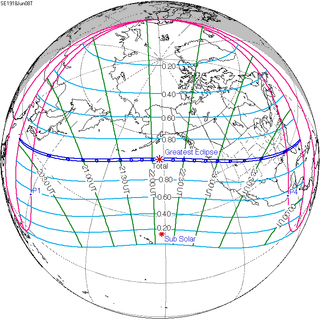Solar eclipse of June 8, 1918
| Solar eclipse of June 8, 1918 | |
|---|---|
| Type of eclipse | |
| Nature | Total |
| Gamma | 0.4658 |
| Magnitude | 1.0292 |
| Maximum eclipse | |
| Duration | 143 sec (2 m 23 s) |
| Coordinates | 50°54′N 152°00′W / 50.9°N 152°W |
| Max. width of band | 112 km (70 mi) |
| Times (UTC) | |
| Greatest eclipse | 22:07:43 |
| References | |
| Saros | 126 (42 of 72) |
| Catalog # (SE5000) | 9324 |
A total solar eclipse occurred on June 8, 1918. The eclipse was observed by a U.S. Naval Observatory team at Baker City in Oregon. The painting below shows totality when the moon prevented the sun's rays from hitting that part of Oregon. The track of the eclipse went across the United States.
The path of the eclipse started south of Japan, went across the Pacific Ocean, and then across the United States. The largest city to see totality was Denver although many could theoretically see it as the size of the shadow was between 70 and 44 miles (113 and 71 km) across as it travelled across America. The longest duration of totality was in the Pacific at a point south of Alaska. The path of the eclipse finished near Bermuda.
The path clipped Washington State and then moved across the whole of Oregon and then the rest of the country exiting over Florida. The U.S. Naval Observatory obtained a special grant of $3,500 from Congress for a team to observe the eclipse in Baker City in Oregon. The team had been making preparations since the year before and John C. Hammond led the first members to Baker City on April 11th. The location was important as it influenced the probability of cloud cover and the duration and angle of the sun during the eclipse. The team included Samuel Alfred Mitchell as its expert on eclipses, and Howard Russell Butler, an artist and physicist. In a time before reliable colour photography, Butler's role was to paint the eclipse at totality after observing it for 112.1 seconds. He noted later that he used a system of taking notes of the colours using skills he had learnt for transient effects.
Joel Stebbins and Jakob Kunz from the University of Illinois Observatory made the first photoelectric photometric observations of the solar corona from their observing site near Rock Springs, Wyoming
...
Wikipedia

